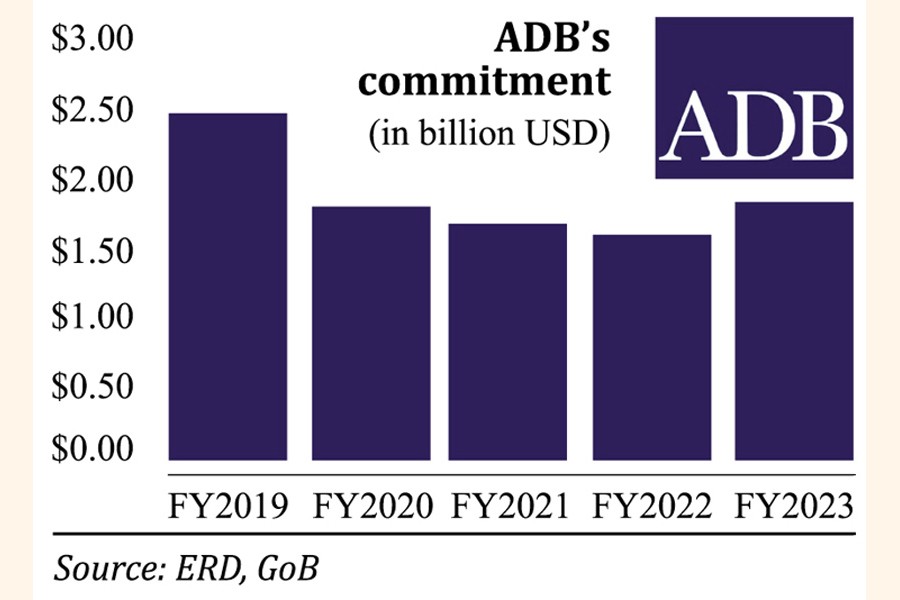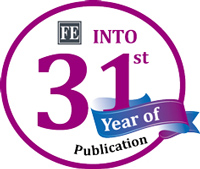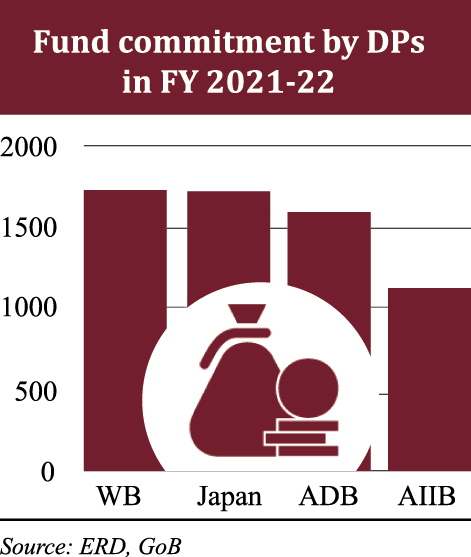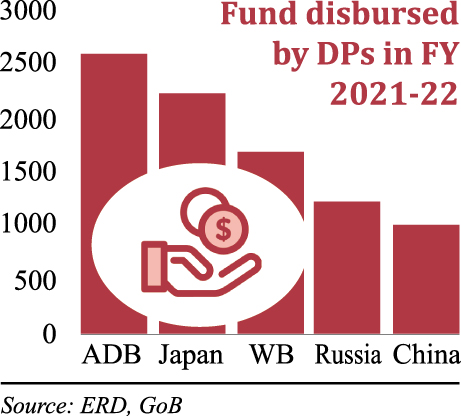
 Bangladesh is witnessing a development carnival on its strides for graduating out of least-developed-country club. It needs billions of dollars worth of ODA (Overseas Development Assistance) for minimising the funding gap in the development expenditure. Since the country has been failing to mobilise expected amount of funds from its internal sources through revenue generation, foreign investments are very important to the country. With the growing need for development of infrastructure as well as of social sector, higher dollops of ODA are required.
Bangladesh is witnessing a development carnival on its strides for graduating out of least-developed-country club. It needs billions of dollars worth of ODA (Overseas Development Assistance) for minimising the funding gap in the development expenditure. Since the country has been failing to mobilise expected amount of funds from its internal sources through revenue generation, foreign investments are very important to the country. With the growing need for development of infrastructure as well as of social sector, higher dollops of ODA are required.
After the country's independence in 1971, Bangladesh's traditional development partners provided food and commodity aid in larger amounts than the project aid for reconstructing the wartorn country and alleviate the hunger of the poorer sections population. But the aid scenario started changing from early 90s as the country looked for developing its infrastructure and improving social conditions of the people. The government went for massive borrowing, in a strategy switch, from the development partners for minimising its infrastructure gap as well as for reducing poverty. So, it starts borrow more funds in addition to the normal inflow of the grants. The project aid in the form of loan has swelled a lot over the couple of decades and those external funds started to be invested in bankrolling the country's development agenda.
Some key development partners for Bangladesh, including the World Bank, the Asian Development Bank, the Islamic Development Bank, USAID, the United Kingdom, the United Nations, the European Commission (EC), the European Union, Germany, Japan and other western-world donors emerged and their growing investment in Bangladesh helps in developing the country. The economic growth has also started rising and touched 8.0- percent club in the current decade. But Bangladesh aspires to be a developing nation by 2026 and a developed nation by 2041. So it needs huge investments for infrastructure development as well as for elevating social status of the people. However, its slower growth in internal resource mobilization posed a setback to the mission. As such, the government goes for higher borrowing from the development partners.
Interestingly, the traditional development partners like the WB, ADB, Japan, IsDB, USA, EC, and EU fail to cope with its funding needs for minimising the infrastructure gap of the development-hungry Bangladesh. Since all the multilateral and bilateral development partners (DPs) have some limited portfolios for their member-countries, so they cannot provide money as much as required by a certain member-country or borrowing nations like Bangladesh. Therefore, Bangladesh fails to pull adequate funds for its development needs from those western DPs. And then it started search for some other sources for getting the external ODA.
On the issue of global power balance and cutting hegemony of some western nations, some emerging eastern nations start work for setting up new Multilateral Development Banks (MDBs). China and BRICS countries started to set up some MDBs. Since 2000, the share of the BRICS in the world's (nominal) GDP has grown from 8.0 per cent to 22 per cent. In contrast, the share of the Group of 7 (G7 -Canada, France, Germany, Italy, Japan, the United Kingdom and the United States) has declined from 65 per cent to 45 per cent.
Although the annual portfolio of WB, ADB and Japan to Bangladesh has got enhanced a lot over the last one decade, but their investments are not enough against the growing development needs. The global lender WB and the Manila-based lender ADB could provide maximum $2.0 billion worth of funds on average per year. The largest bilateral donor -Japan-has also enhanced its annual portfolio at a range of $1.5 billion to $2.0 billion a year in recent times. But those are not still enough. Bangladesh needs much more money. Therefore, Bangladesh government took an initiative to explore new ODA destinations over the last one decade. The government mission yielded a good result over the last few years. It has gone to different non-traditional development partners like France-based EIB, Germany-based GIZ and KFW, Vienna-based OPEC, Russia, China, and India. The country's steps toward enhancing the ODA had got a big boost when two big multilateral development partners-Asian Infrastructure Investment Bank (AIIB) and the New Development Bank (NDB)-emerged on the global MDBs map in 2014. The emerging eastern economy, China, has played a pivotal role in setting up the multilateral banks. It has teamed up with the BRICS countries.
In July 2014, Brazil, Russia, India, China and South Africa - the BRICS - agreed to establish a new multilateral development bank (MDB), the New Development Bank (NDB). In October of the same year, China and 20 other Asian nations signed an agreement to create the Asian Infrastructure Investment Bank (AIIB). The NDB had US$50 billion in initial capital subscription while the AIIB began with US$100 billion in authorized capital. The AIIB has already expanded its membership to 103 nations across the globe. Meanwhile, the NDB has increased its membership and now reached eight. It has also plan of expansion of the newly set-up NDB in the future days. Bangladesh joined the AIIB from its very beginning in March 2016. The country's voting power to the China-based lender is 0.7674 per cent and the subscription is 0.6808 per cent of the total portfolio. Similarly, Bangladesh also joined the NDB in 2021 after the opening up of the membership for the countries beyond the five founding BRICS nations.
If we want to see Bangladesh's look-east policy for exploring fresh investments in addition to the current financial and technical supports from the traditional western DPs, we have to analyse the recent portfolios and upcoming possibilities of the western donors and the newly emerged eastern DPs. Besides, we have to review their lending terms and conditions against the country's financial sustainability.
Spotlight on ADB: The Manila-based lender is a key source of external assistance for Bangladesh, providing $2.0 billion on average every year since 2016. ADB's assistance is aligned with the country's 8th Five-Year Plan 2021-2025 and the Perspective Plan encompassing 2021-2041. Till last year, 2022, the ADB had committed 701 public- sector loans, grants, and technical assistance totaling $28.3 billion to Bangladesh. Meanwhile, the ADB has disbursed cumulative loans and grants to Bangladesh amounting to some $21.19 billion. Currently, its ongoing sovereign portfolio in Bangladesh includes 70 loans and 4 grants worth $11.31 billion.  The ADB committed $1.6 billion in public- sector loans and grants to Bangladesh in 2022.
The ADB committed $1.6 billion in public- sector loans and grants to Bangladesh in 2022.
Over the last few years, the Bank has disbursed nearly $1.5 billion worth of assistance on average every year. If we review aid-commitment and-disbursement trend of the Manila-based lender, we will get a better picture about the recent trends in support of the ADB. It made commitment of $2.46 billion in FY2019, $1.79 billion in FY2020, $1.65 billion in FY2021, $1.60 billion in FY2022 and $1.85 billion in FY2023. On the other hand, the lender disbursed $1.25 billion in FY2019, $1.71 billion in FY2020, $1.31 billion in FY2021 and $2.63 billion in FY2022.
The ADB usually provides two types of loans for Bangladesh. One is the fixed-rate (concessional OCR loan -COL) while another one is floating rate-based (Ordinary Capital Resources OCR) terms. The ADB, a key multilateral development partner of Bangladesh, committed a $1.85- billion loan in FY2023 where the concessional or fixed-rate loan was much lower than the floating rate-based loan. Nearly four-fifths of the loan have been confirmed on market-based rates, which vary between 6.0 and 7.0 per cent. On the other hand, the fixed rate charged is a 2.0-percent rate. The maturity of the loan is 20 years with a 5.0-year grace period.
World Bank: The World Bank was the first multilateral development partner to support Bangladesh after the independence in 1971. Since independence, the World Bank's concessional lending window - the International Development Association (IDA)-- has made commitment of about $40 billion in grants, and the interest-free and concessional credits to the country. Currently, Bangladesh has the largest IDA programme in the world with a total of $16.46 billion worth of commitment for 57 ongoing projects.
Under the IDA-20 package worth $93 billion, to be spent for three years (FY2023-FY2025) in its member- countries, Bangladesh is expecting some US$4.0 billion to $4.5 billion in financial support from the WB. It means Bangladesh is expecting nearly $1.5 billion on average a year.
Let us see WB's financial support over the last few years. The Washington-based lender made commitment of $2.97 billion in FY2019, $1.05 billion in FY2020, $2.83 billion in FY2021 and $1.68 billion in FY2022. On the other hand, the WB disbursed $2.03 billion in FY2019, $1.51 billion in FY2020, $1.64 billion in FY2021 and $1.74 billion aid in FY2022 to Bangladesh.
The World Bank is lending to Bangladesh at zero-to market-based interest rates. The country received a loan commitment of $3.6 billion from the Washington-based lender in the FY2023, the highest ever in a single year, at 1.25-percent interest and 0.75-percent service charge. The data on its disbursed amount in the last fiscal year, FY2023, are yet to be recorded. Currently, the maturity of the IDA loan is 25-30 years and the grace period is 4-6 years. The IDA between FY1972 and FY2022 committed $37.39 billion worth of aid while disbursed 26.67 billion for Bangladesh's development and alleviating hunger.
Development partnership with Japan: After the independence, Japan is the largest bilateral development partner of Bangladesh. It has been providing nearly $1.50 billion on average a year over the last few years. According to government statistics, the Japanese development partner JICA made a commitment of $2.60 billion in assistance in FY2019, $3.15 billion in FY2020, $2.66 billion in FY2021 and $1.77 billion in FY2022. On the other hand, it disbursed $1.19 billion aid in FY2019, $1.69 billion in FY2020, $1.94 billion in FY2021 and $2.31 billion in FY2022. Meanwhile, Japan, since FY1972, has made a confirmation of $28.82 billion worth of assistance for bankrolling Bangladesh's development recipe. It has released $18.52 billion worth of funds till FY2022.
The loans from JICA are most concessional one compared to any external loans to the Bangladesh government. The Japanese development partner JICA charges 1.20 per cent to 1.60 per cent as interest for their loan to Bangladesh. Its maturity is 30 years with a grace period of 10 years.
Newcomer AIIB: The AIIB has so far lent $3.27 billion to Bangladesh against 18 projects after granting the first loan worth $165 million in a project in 2016. Some other projects are in the pipeline for getting funds from the Beijing-based lender. Bangladesh is expecting US$4.5 billion worth of loans, nearly $1.0 billion each a year, from the Asian Infrastructure Investment Bank (AIIB) in next five years.
The terms and conditions of the infrastructure financier is comparatively harder than that of the traditional DPs like ADB and WB. The newly emerged lender provides loan at floating rate with a shorter maturity period. It charges interest based on SOFR where there is a spread within a range of 0.5 per cent to 1.6 per cent is included. Currently, SOFR rate is much higher. On November 13, the 6-month average SOFR rate was 5.27768 per cent. Additionally, a 0.25-percent front-end fee and a 0.65-percent commitment fee are applicable to AIIB loan. It means the overall interest rate on AIIB loan is nearly 7.0 per cent which is almost equivalent to commercial credits. The maturity period of its loan varies between 13 years and 30 years. The grace period varies between three years and five years.
How NDB operates: The government of Bangladesh also took membership of the Shanghai-based lender, NDB, in 2021. After getting the membership, the lender and the borrower completed some processes for availing assistance. The government recently made a law in parliament for ratifying Bangladesh's accession to the new BRICS-sponsored DPs. After getting membership, Bangladesh applied for loans for some seven projects. Out of the lists, two have already been selected for help by the lender. The NDB is likely to get at least $765 million worth of two loans for the first time from the Shanghai-based lender. The NDB is expected to lend some $320 million by December this year for Dhaka WASA's water- supply development and another $440 million for gas-transmission- line development for Titas Gas. The Economic Relations Division (ERD) hopes that the NDB will provide $1.0 billion in assistance per year.
The loans from the NDB will also be market-based like that of the AIIB. The NDB charges at the Secured Overnight Financing Rate (SOFR) and adding a specific spread. Similar to the AIIB, the NDB offers loans with floating interest rates ranging from SOFR+1.30 per cent to SOFR+1.65 per cent. Additionally, a 0.25-percent front-end fee and a 0.65-percent commitment fee are applicable. The maturity of the loan is alike AIIB's.
 Partnership with China: China has emerged as one of the key DPs in Bangladesh over the last few years in development strides. The country is supporting Bangladesh's infrastructure development providing financial support. Through the Belt and Road Initiative (BRI), introduced by China in 2013 as a flagship development model, the country has started to boost its financial support to Bangladesh aside other low- and middle-income countries for infrastructure development. Until 2022, the cumulative BRI engagement in 147 countries by China had stood at $962 billion, according to the Green Finance and Development Centre under Shanghai-based Fudan University.
Partnership with China: China has emerged as one of the key DPs in Bangladesh over the last few years in development strides. The country is supporting Bangladesh's infrastructure development providing financial support. Through the Belt and Road Initiative (BRI), introduced by China in 2013 as a flagship development model, the country has started to boost its financial support to Bangladesh aside other low- and middle-income countries for infrastructure development. Until 2022, the cumulative BRI engagement in 147 countries by China had stood at $962 billion, according to the Green Finance and Development Centre under Shanghai-based Fudan University.
Bangladesh has already been getting nearly US$1.0 billion worth of loan commitment from its eastern DP, China, over the last few years. Till last FY2022, Chinese active loan in Bangladesh had been recorded at $6.97 billion against 21 development projects. China made the loan commitment over the last one decade (2012 to 2022). China charges 2.0 to 3.0 per cent as interest and 0.25-percent service charge for its loans. Maturity of the loan is 15 years with a grace period of five years.
On Russia in development cooperation: Russia emerged as one of the biggest bilateral development partners of Bangladesh in 2013 with its commitment of $500 million worth of loans for the preparatory work of the Rooppur nuclear power- plant project. It later made commitment of $11.38 billion worth of loans in 2016. Currently, these two Russian loans are active in Bangladesh.
The interest rate on the biggest $13.38-billion loan from Russia is being charged at SOFR +1.75 per cent. However, as per the loan agreement, the rate of the loan will not exceed 4.0 per cent. The maturity of the Russian loan is 20 years with a grace period of 10 years.
France's EIB: The French donor agency has also emerged as one of the key development partners of Bangladesh. The French DP provided 5 loans in Bangladesh worth Euro 635 million. The EIB charges 6-month EURIBOR rate for the loans. The 6-month EURIBOR rate on November 14 was 4.097 per cent. The maturity of the loan is 16 to 19 years, including a grace period of 4-6 years.
Which one is important-- western or eastern DP?
From the global perspective, we have tried to review the current and future activities of the newly emerged development partners as well as of the traditional western DPs. The Shanghai-based New Development Bank (NDB), also known as the BRICS Bank, was founded in 2014. It is a significant institution, but not a big player among the multilateral development banks. So far, the NDB has disbursed about $15 billion in infrastructure financing. The World Bank Group, by a contrast, disbursed more than $60 billion in 2021. The major shareholders of the NDB are Brazil, Russia, India, China and South Africa. The governance system is well- designed. The BRICS members are in control. The bank is a worthy start, but not making a difference in global affairs yet.
The AIIB is another new international financial institution. It is headquartered in Beijing, the capital city of China. With total disbursements worth about $20 billion so far, it is not a big player either. China is the dominant power, though the AIIB now has 103 member-states, including major EU countries such as Germany, France and Italy. Beijing took the initiative to start the AIIB before the NDB was even discussed in the BRICS context. There is no resident board of directors, so the president has a lot of leeway. Rules concerning social or environmental protection are quite flexible, and efficiency and flexibility have been declared to be the top priorities.
It is quite obvious that the AIIB is more important in the eyes of China's leaders. To a large extent, it supports the regime's foreign policy, including its massive international infrastructure programme called Belt and Road Initiative (see main story). Moreover, China is running many other international funding programmes which are geared to forging partnerships with countries in several world regions, including Africa, Central Eastern Europe or Latin America. Region-specific summits are held in Beijing regularly as well.
From Bangladesh's perspective, the western MDBs like the World Bank, and the ADB are the biggest partners for Bangladesh. Among the bilateral DPs, Japan is the biggest one. These three DPs have been facilitating Bangladesh's development works through their financial support since FY1972. Just after independence in 1971, the war-ravaged Bangladesh was reconstructed through the financial support of different western development partners, especially from the WB, the ADB and Japan. Their loans were very much concessional up to 2014. But when Bangladesh's income status got boosted in 2015, then the loans from those trios stared to be a bit harder. Based on the per-capita-income threshold, the WB categorized Bangladesh as Lower Middle-Income Country (LMIC) in 2015. Thereafter, the DPs stared to make their terms and conditions for getting loan a bit harder. But major portions of the total annual loans from the WB, the ADB and Japan still carry bellow 2.0- percent rate of interest with longer maturity and grace periods. But the rate of interest for those loans will also be increasing in next decades when Bangladesh will graduate to a developing nation from its current status of LDC.
On the other hand, the eastern DPs, including AIIB and NDB, have offered market-based rate for its borrowing countries, which currently varies in-between 6-7 per cent. The maturity is also much lower than that of the loans from the western DPs.
Meanwhile, Bangladesh's infrastructure-development demand is very high. Besides, its investment for social-service improvement is still in the preliminary stage. So, the country needs massive investments in the future days, too. In that case, the western DPs have not the capacity to provide finance against Bangladesh's growing demand. So, the addition of the eastern DPs is somehow a blessing for Bangladesh.
Despite the harder terms and conditions, Bangladesh's new window of getting investments for infrastructure development has been opened up. The country can now get more funds from different options. So, the emergence of the new development partners is complementary, not contradictory. Bangladesh has now to ensure the best use of the loans and grants from all the DPs.
The writer is a senior journalist and development analyst.
kabirhumayan10@gmail.com
© 2025 - All Rights with The Financial Express
